

Getting It Right. Getting It Right As a secondary English methods professor, I wish I could get it right every time.
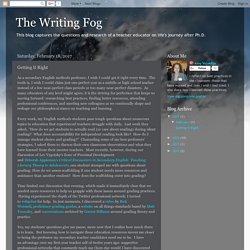
The truth is, I wish I could claim just one perfect year as a middle or high school teacher instead of a few near-perfect class periods or too many near-perfect disasters. As many educators of any level might agree, it is the striving for perfection that keeps us moving forward: researching best practices, finding better resources, attending professional conferences, and meeting new colleagues as we continually shape and reshape our philosophical stance on teaching and learning.Every week, my English methods students pose tough questions about numerous topics in education that experienced teachers struggle with daily. Last week they asked, "How do we get students to actually read (or care about reading) during silent reading? Six Principles For A Networked Community Strategy. (Photo: Shutterstock) The “Airbnb community,” the “Linux community,” the “Nike running community:” in our networked age, who isn’t talking about “community” as part of their strategy?
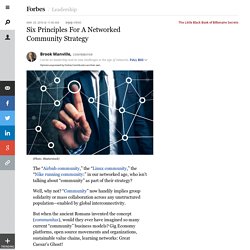
Well, why not? “Community” now handily implies group solidarity or mass collaboration across any unstructured population—enabled by global interconnectivity. But when the ancient Romans invented the concept (communitas), would they ever have imagined so many current “community” business models? Broadcast Yourself. PLN: Your Personal Learning Network Made Easy. What is a PLN?

If I had to define what a ‘Personal Learning Network’ is, I would keep it simple and broad: n. – the entire collection of people with whom you engage and exchange information, usually online. Personal Learning Networks, or PLNs, have been around forever. Originally, they were your family and friends, maybe other educators you worked with, but as the internet and web 2.0 tools have become nearly ubiquitous, PLNs can include tons of different communities – social networking sites like Facebook, blogs, Twitter, wikis, social bookmarking tools, LinkedIn, and so many more. EJ972454.
Step 1: What is a PLN? Welcome to our professional learning series on building a PLN.

This series guides you step by step through the process of setting up your own PLN. Social Media in Education: Resource Toolkit. Creating Social Media Guidelines A Guidebook for Social Media in the Classroom, by Vicki Davis (2014) Davis, in the first half of a pro-and-con discussion about social media in the classroom, positions it as a vital life skill and provides 12 positive examples of classroom use.
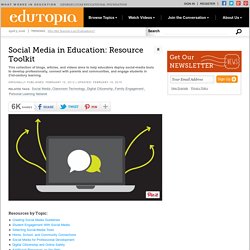
For the second half of the discussion, read this post by Ben Johnson: "Too Much Technology and Not Enough Learning? " MyNotes: Best Practices for Professional Learning Communities. Source: Print Article: Best Practices for Professional Learning Communities MyNotes: One Sentence Summary: The focus of PLCs is ongoing “job-embedded learning,” emphasizing teacher leadership, active involvement and deep commitment to school improvement methods dependent on schools that embrace a culture that supports collaboration, an objective view of their efforts, and share beliefs/behaviors.
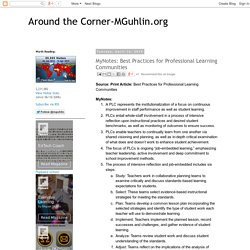
Quotes: The focus of PLCs is ongoing “job-embedded learning,” rather than one-shot professional development sessions facilitated by outsiders, who have little accountability regarding whether staff learning is successfully applied.PLCs emphasize teacher leadership, along with their active involvement and deep commitment to school improvement efforts. Everything posted on Miguel Guhlin's blogs/wikis are his personal opinion and do not necessarily represent the views of his employer(s) or its clients. Express 8.09 - The What and Why of a Professional Learning Network.
The What and Why of a Professional Learning Network Tom Whitby It is a great time to be an educator in the United States, and, simultaneously, it is the worst time to be an educator in the United States.
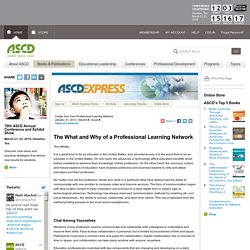
On one hand, the advances in technology afford educators benefits never before available to advance their knowledge of their profession. On the other hand, the economy, culture, and misconceptions of education have enabled politicians and business leaders to vilify and attack educators and their profession. No matter how old the profession, those who work in a particular field have always had the ability to communicate with one another to compare notes and improve services. Chat Among Yourselves. 2014 Social Media Demographics Update. Professional Learning Networks & Practice. You are being invited to participate in a research study titled “Professional Learning Networks and Educator Practice.”

This study is being done by Torrey Trust, Ph.D. from the University of Massachusetts Amherst, Dan Krutka, Ph.D. from Texas Woman's University, and Jeffrey Carpenter, Ph.D. from Elon University. The purpose of this research study is to examine how professional learning networks (aka "personal learning networks") shape educators’ practices and student learning. If you agree to take part in this study, you will be asked to complete an online survey. This survey will ask about your professional learning network. It will take you approximately 5-10 minutes to complete. The benefit of participating in this study is the opportunity to share your experiences, knowledge, and expertise with the researchers.
Two Case Studies: How Connected Educators Can Transform Schools. Figuring out which new teaching practices or pieces of technology might work in a classroom can feel like a full-time job.

Lots of educators spend their free time researching new ideas and connecting with other educators, but there are plenty more that find the process confusing and overwhelming. How much easier would it be to have a dedicated staff person whose job is to bring new ideas into the district, support teachers and smooth the way with administrators? That’s what Kris Hupp does for Cornell School District, a tiny district in Pittsburgh, Pennsylvania. Hupp’s official title is 21st Century Teaching and Learning Coach, a job that started out as part of a state grant and has been incorporated into the regular budget.
“My district made the investment in my position because they were seeing instructional shifts and a lot of that is this mentality that we’re in it together,” Hupp said. Break Out of the Silo: Become a Connected Educator. How to build a professional learning community (no matter what job you have) - Daily Genius. Let’s say you have a solid job that lets you have a great work-life balance.
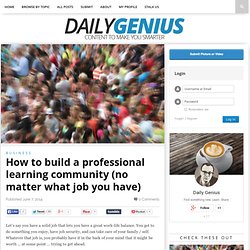
You get to do something you enjoy, have job security, and can take care of your family / self. Whatever that job is, you probably have it in the back of your mind that it might be worth … at some point … trying to get ahead. Maybe you want to learn a new skill and apply for that corner office job? PLN Starter Kit. Intro to communities of practice. The term “community of practice” is of relatively recent coinage, even though the phenomenon it refers to is age-old. The concept has turned out to provide a useful perspective on knowing and learning.
A growing number of people and organizations in various sectors are now focusing on communities of practice as a key to improving their performance.This brief and general introduction examines what communities of practice are and why researchers and practitioners in so many different contexts find them useful as an approach to knowing and learning. What are communities of practice? Note that this definition allows for, but does not assume, intentionality: learning can be the reason the community comes together or an incidental outcome of member’s interactions. Stages of PLN adoption. David Warlick wrote a post the other day about being able to zip up or turn off your Personal Learning Network (PLN).
I too have been thinking about how one goes about starting a PLN, how do you monitor it, and how do you learn to shut it off. We all continue to push teachers to start PLNs if they haven’t already. Learning from the collective knowledge of educators around the world. I have noticed an emerging trend of what one goes through when adopting a PLN for the first time. I myself continue to look at the stages I am going through in adopting this new way of learning, interacting, and teaching in a collaborative, connected world. PLN Starter Kit. Personal Learning Networks for Educators. Personal learning network. Personal Learning Networks for Professionals – #aitd2012. My Classroom Observation. During the course of the semester, I had the opportunity to observe a seasoned instructor at ESL services here at UT.
The course that I observed was an Intermediate Reading and Discussion class. I felt very fortunate to have been able to observe this class. The instructor created an environment that was conducive to learning in which all the students appeared to feel at ease due to her warm, friendly personality and also because she was approachable and appeared to possess a genuine interest in hearing her students' opinions. Infographic: #PLearning Framework (Part 2 of the Series) - Getting Smart by Guest Author - learning, personalized learning, plearning, students. By: Justin DeLeon #PLearning Framework (Part 2 of the Series) first appeared on Education Elements on April 2, 2014. When you think of “personalized,” you probably think “unique,” “special,” and “just for me.” For the most part, we personalize as much of our lives as possible. Intro to communities of practice. 06-Brief-introduction-to-communities-of-practice. Personal Learning Networks for Educators: 10 Tips - Getting Smart by Guest Author - edchat, EdTech, PLN.
By Dr. Mark Wagner. Visions that Blind.